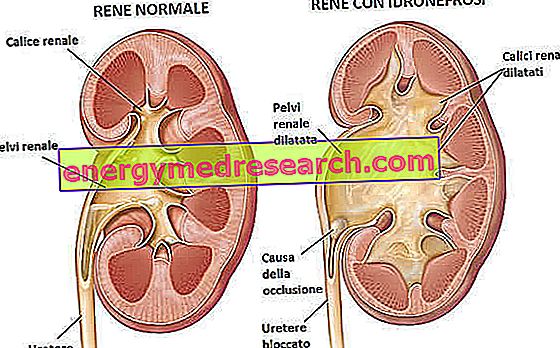Generality
Hydronephrosis is a particular pathological circumstance, characterized by the accumulation of urine inside the kidney. This accumulation, which causes renal swelling, is due to an obstructive blockage of the urinary tract, which normally leads outside the urine formed in the kidneys. The occlusion of the urinary ducts has different causes; it usually originates after the formation of kidney stones, but this is not the only motivation. Therefore, a precise diagnosis is needed to establish not only the extent of hydronephrosis, but also (and above all) the causes.
Knowing the precise reasons for this kidney disorder helps plan the most appropriate treatment.
An appropriate therapeutic intervention, timely and rapid, can be fundamental to avoid the onset of complications, sometimes even serious ones.

Figure: comparison between healthy kidney (left) and kidney with hydronephrosis (right). One can appreciate how the internal anatomy of the kidney changes when it accumulates urine. The renal pelvis swells, renal calices expand and the ureter is blocked. From the site: biology-forums.com
Kidneys and urinary tract
Anatomical references
The kidneys are two and represent the main organs of the excretory apparatus ; together with the urinary tract, they constitute the urinary system . The kidneys reside in the abdominal cavity, on the sides of the last thoracic vertebrae and the first lumbar vertebrae, they are symmetrical and their shape resembles that of a bean.
The main renal functions are:
- Filter the harmful and foreign waste materials present in the blood and convert them into urine
- Adjust the hydro-saline balance of blood
- Adjust the acid-base balance of blood
The blood, on which the kidneys act, comes from the renal artery and returns to the venous system entering the renal vein, which then joins the vena cava .
The kidney is composed of different structures, which can be viewed in the figure below.

THE STREETS OF THE URINARY TRACT
The urinary tract routes consist of:
- Two ureters (one for each kidney). They are the ducts, which run from the kidneys to the bladder.
- The bladder . It is a small hollow muscular organ, which accumulates urine before urination.
- The urethra . It is the duct that serves to lead urine outside. In humans, it crosses the penis; in women, it is more and more short and flows into the vulva.
NB: under the bladder, only in men, there is another very important organ: the prostate . Although it belongs to the reproductive system, it plays a key role in the onset of some forms of hydronephrosis.
What is hydronephrosis
The term hydronephrosis indicates a particular pathological condition, affecting the kidneys, in which the renal pelvis (or renal pelvis ) and the renal calyces are dilated and swollen due to a stagnation of urine.
The accumulation of urine is consequent to an impediment of its outflow, which in turn can be determined by an internal obstruction (eg calculus) or by the external compression of one of the ducts that make up the renal tract (eg prostatic hypertrophy) .
Hydronephrosis usually affects only one kidney ( unilateral hydronephrosis ), but it cannot be excluded that it may also be bilateral .
If the appropriate therapeutic treatments are not used, the affected kidney undergoes atrophy, or a reduction in its volume and its functions.

Figure: bilateral and unilateral hydronephrosis compared. The renal pelvis swells due to urine accumulation; the accumulation is due to an external obstruction (example on the left) or an internal one (example on the right) of the urinary tract, which leads urine to the outside. The various components of the urinary tract can be recognized: kidneys, ureters, bladder and urethra. From the site: biology-forums.com
FETAL HYDRONEONE
Alongside the forms of hydronephrosis that affect adults (young or old without any particular distinction), there is another type of hydronephrosis, which occurs in the prenatal age. It is defined by the alternative terms of fetal hydronephrosis and prenatal hydronephrosis .
This is a very common situation and not particularly dangerous for either the fetus or the mother: in fact, 4 out of 5 cases resolve more than positively, just after birth.
Epidemiology
The annual incidence of unilateral hydronephrosis is one case per 300 people; that of bilateral hydronephrosis, on the other hand, is one case per 600 people.
Very often associated with kidney stones, hydronephrosis appears to represent more than 80% of all kidney diseases.
A particular age of major onset has not been estimated and it seems that both males and females are affected equally. However, it must be specified that some triggering causes can occur either only in humans or only in women.
Fetal hydronephrosis, unlike the typical forms of adults, is much more common: it affects, in fact, one fetus every 100 pregnancies.
Causes
The pathological condition of hydronephrosis occurs when one of the following two situations occurs:
- Internal block of a urinary tract pathway
- External compression of the ducts or cavities of the urinary tract
In both cases, the urine is not expelled and accumulates inside the kidney, in the renal pelvis and in the goblets.
But what are the precise causes that cause an impediment to urinary flow?
As will be seen below, the most common causes of hydronephrosis can be divided into three categories: those common to both sexes, those specific to the male sex and those specific to the female sex. The etiological framework will also be completed, reporting the less frequent causes (regardless of whether they are typical only of men or women) and those triggering the fetal hydronephrosis.
THE CAUSES COMMON TO BOTH THE SEXES
The common cause for men and women, capable of causing hydronephrosis, is the presence of so-called kidney stones . Kidney stones are small aggregates of mineral salts, which form inside the urinary tract and compromise the normal flow of urine. When one or more kidney stones obstruct the ureter, the urine is no longer expelled; consequently, it accumulates upstream of the obstruction, ie in the kidneys.
Deepening: How do kidney stones form?
As mentioned, kidney stones are small aggregates of mineral salts, which are created inside the urinary tract and prevent the passage of urine.
To cause its formation is an imbalance between the liquid present in the kidneys (a liquid that will then become urine) and the electrolytes (precisely the mineral salts of the kidney stone) dissolved in it.
This imbalance can be created either because the renal fluid is reduced (for example, in individuals who drink little water) or because the mineral salts increase (for example, following an immobilization by bone fracture). However, in both cases the consequences of this are the same, namely the precipitation of the salts contained in the urine and their aggregation.
THE CAUSES OF MAN
The most frequent causes of hydronephrosis in male individuals are two:
- A benign prostatic hyperplasia (or prostate adenoma )
- A prostate tumor
In both cases, there is an increase in the volume of the prostate gland, which compresses one or both ureters. As a result of the pressure exerted, the flow of urine can be interrupted, causing the urine to stagnate at a renal level.
THE CAUSES IN THE WOMAN
The causes of hydronephrosis in female individuals are, instead, three:
- The state of pregnancy
During a pregnancy, the uterus can enlarge to the point of compressing the ureters and closing the passage.
- A tumor in one of the organs of the urinary tract
These are usually tumors of the bladder or one of the two kidneys. In both cases, abnormal tissue forms, which pushes on the ureter, occluding it.
- A tumor on one of the organs of the reproductive system
In such situations, the organs involved may be the uterus (or only part of it, that is, the cervix) or the ovaries. The ureter is compressed even in this case by the abnormal growth of tumor tissue.
Low recurrent causes of hydronephrosis
- Blood clot, due to embolism, created in the urinary tract
- Endometriosis
- Tuberculosis
- Neurogenic bladder
- Ovarian cysts (or polycystic ovaries)
- Stenosis of the ureter, following an infection, surgery or injury
NB: the above list includes pathological situations common to men and women, but also exclusive to the female sex. However, it should be specified that the distinction parameter used, in this case, is that of recurrence and not sex.
OTHER CAUSES
So far we have talked about the most frequent causes of hydronephrosis. However, this disorder can be caused by other more rare situations, which the reader may know from the table on the side.
THE CAUSES OF FETAL HYDROPHONES
There are two potential causes of fetal hydronephrosis.
First cause. An obstruction of the ureters may develop, at the point where they join the kidneys. There is no precise reason to explain what determines this occlusion.
Second cause. The valve that controls the passage of urine between ureter and bladder may be defective and cause urinary reflux. Urinary reflux means that urine flows back from the bladder to the kidneys through the ureter. This condition is known as primary vesicoureteral reflux and very often resolves spontaneously at birth.
CONTINUE: Hydronephrosis - Symptoms, Diagnosis, Cure »



